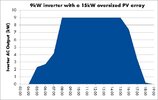Just to be clear, that's the same as saying "I would want a system that is designed to have a somewhat higher $/kWh generated than the optimum." Or another way of saying it is "I prefer to underutilize my inverter capacity and fully utilize my panel capacity, I don't care about finding the economically optimal balance between sizing the two resources."
Cheers, Wayne
Thats true but that's not the question. We are relying on Tesla to put together package systems. The quote above means basically this. "OK, with these smaller inverters you will get 10000kwh per year. With a larger inverter, changing no other spec, you will get 11,000 per year, but it would cost $1000 more.
At 25 cents per kwh, 1000 is worth $25 per year, or $500 over the twenty year life of the system. So if you are going to get charged more than you get, well, that's what people are pointing out.
But that's different than saying that Tesla can make $1,000 less profit if they size the inverter to allow maximum production.
That question gets to the heart of the matter. Tesla is not charging by kwh. If they were, the price of a system in SoCal would be different than one in Seattle. If a given system, say mine, clips five days a year that's one thing. But if it clips 50 days a year, all that clipping has to do is result in 8 kwh loss in each day to equal 400kwh per year, or 8,000 over the 20 year life of the system (which is what I'm buying) or $2,000 less to me. So if its between Tesla making $1000 more profit v. me getting $2,000 less I vote me.
If its a different scenario, and I pay all the cost items, I could indeed chose more panels over a larger inverter if the price of panels to the price of the larger inverter warrants it.
But that's not the question, is not like many buyers have the option when ordering through Tesla to select more panels. The question is should the inverters be sized in the spec to have only minimal or no clipping?. I say yes.
If Tesla wants to change the whole analysis and say, "we are selling a system which will produce a minimum of X and a maximum of Y (because the maximum production is limited by the inverter)" they ought to say so. But they are not making that representation.



